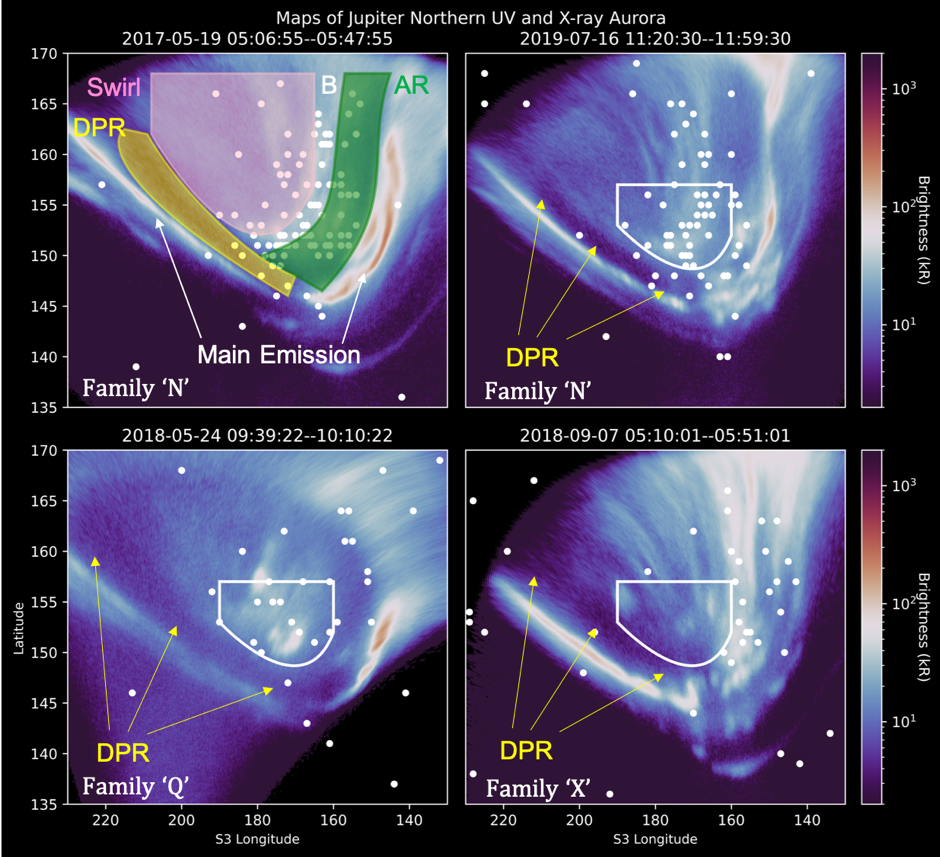MIST
Magnetosphere, Ionosphere and Solar-Terrestrial
Jupiter’s X-Ray and UV Dark Polar Region
By Daisy May and Ben Sipos (St Gilgen’s School)
Jupiter produces powerful ultraviolet (UV) and X-ray aurorae at the planet’s poles. The emissions take on a variety of dynamic structures, particularly in the swirl and active regions (Figure 1). However, the dark polar region (DPR) consistently demonstrates a lack of auroral emissions. 14 simultaneous Chandra X-ray Observatory and Hubble Space Telescope observations of Jupiter’s Northern aurorae (between 2016 and 2019) revealed that no statistically significant X-ray signature is detectable within the DPR.
There were two potential non-DPR sources that might have contributed DPR photons, that needed to be considered. The first source was scattered solar photons. By shifting a region the same shape and size as the observed DPR across non-auroral longitudes of the planet, and scaling the photon counts to the duration of the HST observation, we determined the expected number of scattered photons in the DPR for each observation (0.3 to 1.4 counts depending on the DPR size, distance to Jupiter, and solar activity).
The second source was emissions perceived to have come from within the DPR due to the spatial uncertainty of the X-ray Observatory. To determine the count of such photons, we simulated where photons that were produced from the active and swirl regions would have been detected when passed through the spatial uncertainties applied by the X-ray observatory. After 100,000 simulations for each observation, we determined the count of such falsely detected photons, and found that there is no statistically significant X-ray detection from the DPR for these 14 observations.
The lack of x-rays implies low levels of precipitation by solar wind and energetic magnetospheric ions in the DPR. Therefore, the observations are consistent with the DPR being associated with either: Jupiter’s open field line region and/or the DPR containing different potential drops or an absence of the strong downward currents and/or wave-particle interactions present across the rest of the polar aurorae.
This research project was undertaken with the Orbyts programme which partners scientists with schools to support school student involvement in research and to improve inclusivity in science. This nugget was written by two school students who produced a significant proportion of the work in the associated paper.

Figure 1: Overlaid simultaneous UV (blue-white-red color map) and X-ray photon (white dots) longitude-latitude maps of Jupiter's North Pole, from the Hubble Space Telescope (HST) and Chandra X-ray Observatory High Resolution Camera (CXO-HRC). Dates and times of the observations (UT) are at the top of each panel. Only UV and X-ray emissions produced during this time window are shown. Jupiter’s main emission is labelled by white arrows, the dark polar region (DPR) is shown in yellow, the Swirl region is shown in pink and the Active Regions (sometimes split into a noon and dusk active region) are shown in Green. The boundary between the active region and swirl region (here labelled with a white “B”) sometimes includes an arc of UV and X-ray emission, as is the case for the two different observations shown in the top two panels here. The other panels highlight three different UV aurora families, as indicated by the white label in the lower left corner of each (Grodent et al. 2018). The white shape overlaid onto each map is consistent across each, and highlights the changing spatial distribution of X-rays for each. For each panel, the location and extent of the DPR are indicated with yellow arrows, showcasing its changing extent from observation-to-observation.
References: Grodent, D., Bonfond, B., Yao, Z., Gérard, J.-C., Radioti, A., Dumont, M., et al. (2018). Jupiter’s aurora observed with HST during Juno orbits 3 to 7. Journal of Geophysical Research: Space Physics, 123(5), 3299– 3319.
Associated Paper: Dunn, W.R., Weigt, D.M., Grodent, D., Yao, Z.H., May, D., Feigelman, K., Sipos, B., Fleming, D., McEntee, S., Bonfond, B. and Gladstone, G.R., 2022. Jupiter’s X‐ray and UV Dark Polar Region. Geophysical Research Letters, p.e2021GL097390.